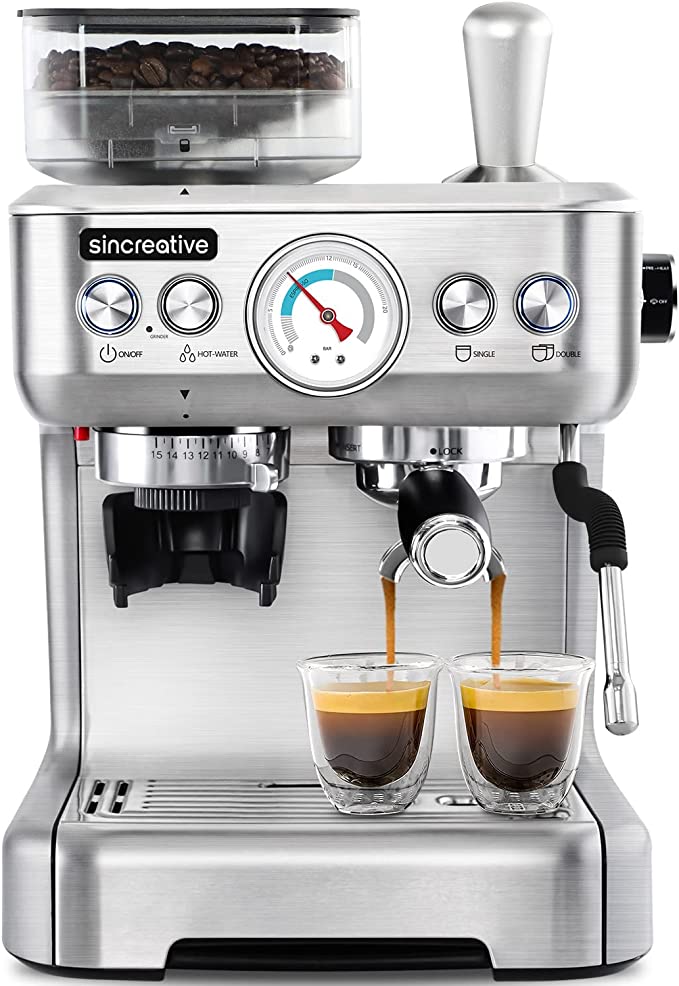ILAVIE CM-5060 Espresso Machine: Barista-Quality Coffee at Home
Update on March 25, 2025, 1:39 a.m.
Coffee. That single word conjures images of bustling cafes, the invigorating aroma of freshly ground beans, and the satisfying first sip of a rich, complex brew. But what truly separates a mediocre cup from an extraordinary one? The answer, in large part, lies in the science of espresso. Let’s embark on a journey to unlock the secrets behind this beloved beverage, exploring the intricate dance of pressure, temperature, and technique that culminates in the perfect shot.

A Sip Through Time: The Story of Espresso
The story of coffee stretches back centuries, with legends of Ethiopian goatherds discovering the energizing effects of coffee berries. From these humble beginnings, coffee cultivation and consumption spread across the globe, evolving into the diverse coffee culture we know today. While various brewing methods emerged, the quest for a stronger, more concentrated coffee experience led to the birth of espresso in late 19th and early 20th century Italy.
Luigi Bezzera, a Milanese businessman, is often credited with patenting the first espresso machine in 1901. His invention used steam pressure to force water through coffee grounds, a revolutionary concept that dramatically reduced brewing time and produced a bolder, more intense beverage. This marked the dawn of the espresso era, forever changing the landscape of coffee consumption.
The Science of Extraction: Pressure, Temperature, and the Perfect Shot
At its heart, espresso is a science experiment. It’s about extracting the desirable compounds – oils, sugars, and acids – from finely-ground coffee beans using hot water under pressure. Several key factors determine the quality of the extraction:
- The 9-Bar Rule: You’ll often hear that 9 bars of pressure (about 130 psi) is the gold standard for espresso extraction. Why this specific number? It’s the sweet spot where the water has enough force to extract the flavorful compounds efficiently without over-extracting and drawing out bitter, undesirable elements. Think of it like squeezing a sponge – you need enough pressure to get the water out, but not so much that you damage the sponge itself. The ILAVIE CM-5060, with its 20-bar pump, is more than capable of achieving and sustaining the pressure. The extra capacity allows for a more stable pressure.
- Temperature’s Tango: Water temperature is equally crucial. The ideal range for espresso extraction is between 195-205°F (90-96°C). At this temperature, the desirable compounds in coffee dissolve readily, contributing to the rich aroma and flavor. If the water is too cool, the extraction will be weak and sour. Too hot, and you’ll scorch the coffee, resulting in a bitter, burnt taste. It is similar to cooking, some material dissolve in warm water, some need to be boiled. The ILAVIE CM-5060 features a 1350W heating system designed for rapid heating and, crucially, consistent temperature maintenance throughout the brewing process.
- Pre-infusion, Grind Size, and the Art of Tamping: Before the full force of the pump is unleashed, a good espresso machine often employs a pre-infusion stage. This involves gently wetting the coffee grounds with low-pressure water, allowing them to bloom and release their aromas. The grind size of your coffee is also critical. Espresso requires a fine grind, which provides a large surface area for the water to interact with. Finally, tamping – the process of compressing the ground coffee into a firm, even puck – is essential for ensuring uniform water flow. Imagine trying to water a garden with uneven soil; the water would channel through the loose areas and bypass the denser ones. Tamping creates a level playing field for the water to extract evenly.
- Double Layer Filter: A double-layer filter, as found in the ILAVIE CM-5060, further refines the extraction process. The dual layers ensure a more consistent water flow, preventing channeling (where water finds the path of least resistance and bypasses some of the grounds). This leads to a more balanced and nuanced espresso.

The Alchemy of Milk: Frothing and Microfoam
For many, espresso is just the starting point. The addition of perfectly textured milk transforms it into a latte, cappuccino, or a myriad of other delightful creations. But frothing milk is more than just blowing bubbles; it’s a delicate dance of physics and chemistry.
- Protein Power and Fat’s Embrace: Milk is a complex mixture of water, proteins (primarily casein and whey), and fat. When steam is injected into milk, the heat causes the proteins to unfold, or denature. These unfolded proteins then surround air bubbles, stabilizing them and creating a foam. Milk fat also plays a role, contributing to the foam’s richness and stability.
- The Microfoam Miracle: The goal of a skilled barista is to create microfoam – a velvety smooth texture composed of tiny, uniform air bubbles. This is achieved by carefully controlling the position of the steam wand and the amount of air introduced into the milk. The ILAVIE CM-5060’s stainless steel steam wand, with its 360-degree rotation, allows for precise control over this process.
- Latte vs Cappuccino: Microfoam is perfect for latte. While for cappuccino, it contains larger bubbles.
- Beyond Cow’s Milk: While whole cow’s milk is traditionally favored for its frothing properties, plant-based alternatives like soy, almond, and oat milk can also be frothed, although their protein and fat compositions will affect the resulting texture.

The ILAVIE CM-5060: A Home Barista’s Companion (But Not a Sales Pitch)
The ILAVIE CM-5060 serves as a practical illustration of how these scientific principles are engineered into a home-friendly appliance. It’s not about promoting the machine itself, but rather using it as a lens through which to understand the why behind each design choice.
- The 20-Bar Pump (Pressure Revisited): As we discussed, 9 bars is the ideal extraction pressure. The CM-5060’s 20-bar pump doesn’t mean it’s over-pressurizing the coffee. Instead, it provides the capacity to consistently deliver that optimal pressure, even during continuous use. Think of it like having a car with a powerful engine – you don’t always drive at top speed, but the power is there when you need it.
- The 1350W Heating System (Temperature Stability): The rapid heating capability of the 1350W system, combined with an intelligent temperature control mechanism, ensures that the water reaches the ideal brewing temperature quickly and stays there. This consistency is key to avoiding the bitter or sour notes that can result from temperature fluctuations.
- The Steam Wand (Microfoam Mastery): The stainless steel construction of the steam wand isn’t just for aesthetics. Stainless steel is durable, easy to clean, and doesn’t react with the milk. The 360-degree rotation provides the flexibility needed to find the perfect angle for introducing air and creating that coveted microfoam.
- Thoughtful Design (Ease of Use): Features like the removable 1L water tank and the removable drip tray might seem like simple conveniences, but they represent thoughtful design. They make the machine easier to fill, clean, and maintain, encouraging regular use and prolonging the life of the appliance.

Beyond the Machine: Mastering the Variables
While a good espresso machine provides the foundation, achieving truly exceptional espresso requires attention to several other factors. It’s a journey of experimentation and refinement.
- Pulling a shot:
- Fill the water tank.
- Pre-heat the machine.
- Grind your beans: Freshly ground coffee is essential for optimal flavor.
- Use the included spoon and tamper to add ground coffee to brewing filter.
- Press the coffee tightly with the tamper.
- Lock the portafilter.
- Select single or double shot.
- Enjoy.
- Troubleshooting:
- Espresso is too watery: Grind finer / tamp harder.
- Espresso is too bitter: Grind coarser / use cooler water (if your machine allows for temperature adjustment).
- Espresso is too sour: Grind finer / use hotter water.
- No Crema: Stale coffee bean/ grind too coarse.
- Water Quality: The water you use makes a significant difference. Hard water, with high mineral content, can affect the taste of your espresso and even damage your machine over time. Filtered water is generally recommended.
- Bean Freshness: Coffee beans are at their peak flavor shortly after roasting. Store your beans in an airtight container, away from light, heat, and moisture.
- Experimentation: Don’t be afraid to experiment! Try different grind sizes, tamping pressures, and even different coffee beans to discover your perfect espresso profile. The journey of discovery is part of the fun.

The Future of Coffee at Home
The world of home espresso machines continues to evolve. We’re seeing more machines with features like programmable pre-infusion, built-in grinders, and even smart connectivity that allows you to control the brewing process from your phone. But regardless of the technological advancements, the fundamental science of espresso remains the same.
Ultimately, understanding the principles of pressure, temperature, and technique empowers you to create exceptional coffee, regardless of the machine you use. It’s about appreciating the journey from bean to cup and savoring the rich, complex flavors that result from a carefully crafted espresso. So, whether you’re a seasoned home barista or just starting your coffee adventure, embrace the science, experiment with the variables, and enjoy the delicious results!







































